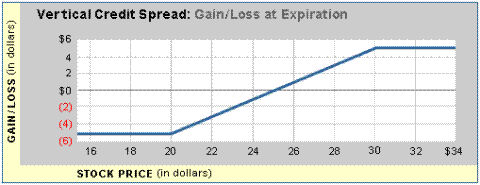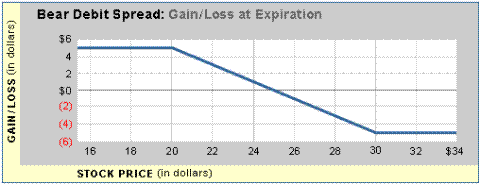How To Exit A Vertical Put Spread
Vertical Put Spreads
A strategy consisting of the purchase of a put option with one expiration appointment and strike price and the simultaneous auction of another put with the aforementioned expiration date, simply a dissimilar strike price. Depending on whether the purchased put has a higher or lower strike than the sold put, a vertical put spread tin by and large be profitable if the underlying stock or index rises (a bull vertical put spread) or falls (a bear vertical put spread) sufficiently.
Bull Vertical Put Spread
Similar to the Bull Telephone call Spread, the Bull Put Spread strategy may allow the investor to profit from an upward motility in the underlying security. To utilize this technique, the investor sells puts at one strike and buys puts at a lower strike that share the same expiration date. The high-strike puts have higher premiums than the depression-strike puts. Equally a effect, the investor will receive a net inflow of capital letter since the price of the options sold exceeds the toll of the options purchased. Consequently, bull put spreads are oft referred to equally 'credit' spreads. To accomplish maximum profit, the underlying security price must rise higher up the strike price of the short (written) put at expiration, rendering both puts worthless.
For apply when investor anticipates:
- Upward market direction / security appreciation
Financial Characteristics:
- Maximum Loss: The difference between the strike prices less the amount received to establish the spread*
- Maximum Turn a profit: Net premium received
Objective*:
- Speculative proceeds
*The maximum loss on a balderdash put spread is limited as long as, and only as long every bit, the integrity of the spread is maintained. If the investor trades out of or exercises the low-strike put, the maximum loss is no longer express to the premium outlay. There is an boosted chance associated with the expiration weekend. If the brusk put is assigned, while the long is non auto-exercised (considering, for case, the stock closes between the two strikes) the investor ends upwards with a long position in the stock. Bad news during the weekend could force fifty-fifty greater losses on the investor before he tin go out the long equity position.
EXAMPLE (Balderdash Vertical Put Spread)
Currently, XYZ trades at $25/share. The investor employs the spread strategy selling ane in-the-money put (Strike $30) for $6.00/share and buying 1 out-of-the-coin put (Strike $twenty.00) for $1.00/share. Using this strategy, the investor receives a cash credit of the difference betwixt the premiums received and the premiums paid (half dozen-one=$5 or $500) and this is the maximum profit the investor can earn. If the stock rises to $30.00/share, the long and short put positions expire worthless and the investor keeps the net premium received. The maximum loss is the difference betwixt the option strikes, less the call premium received (30-xx-5 = $5 or $500) (see * above). The breakeven price of 25 is calculated by subtracting the cyberspace credit of the spread from the strike price of the brusque option.

Bear Vertical Put Spreads
The Conduct Put Spread may let an investor to turn a profit from downward movements in the underlying security. Information technology uses exactly the opposite structure of the Bull Vertical Put Spread and requires the investor to buy a high-strike put and sell a low-strike put (with a lower premium). The sale of the less expensive, out-of-the-money put will partly offset the toll of purchasing the in-the-money put. The maximum the investor can profit is the difference between the strike prices used to create the spread less the cost of establishing the spread. If the security rises in value, the maximum the investor can lose is the difference between the premium paid for the long put and the premium received from the short put.
For apply when investor anticipates:
- Declining market/security depreciation
Fiscal Characteristics:
- Maximum Loss: Net premium outlay (Premium Received – Premium Paid)*
- Maximum Gain: The deviation between the strike prices less the toll of establishing the spread
Objective*:
- Speculative gain
*The maximum loss on a spread position remains limited equally long as, and just as long as, the integrity of the spread is maintained. [If the investor trades out of or exercises the long put, the maximum loss is no longer limited].
EXAMPLE (Bear Vertical Put Spread)
Currently, XYZ trades at $25/share. The investor believes the stock will fall and wants to participate in the downwards motility simply does not want to but buy puts considering of the expense/risk involved. Instead, the investor employs a spread strategy buying an in-the-money put (strike $30) for $half-dozen.00/contract and selling an out-of-the-money put (strike $20) for $1.00/contract. Using this strategy, the maximum loss is the difference between the premiums paid and the premium received* (6-1=$v or $500). The maximum profit an investor can receive is the difference between the strike prices of the options used to create the position less the toll to plant the spread (30-twenty-5=$5 or $500). In this example, the strategy breaks even at $25.00/share. The breakeven toll of 25 is calculated past subtracting the net debit of the spread from the strike toll of the long option.

Commissions, taxes, and transaction costs are non included in any of these strategy discussions, merely can impact final effect and should be considered. Please contact a tax advisor to discuss the tax implications of these strategies. Many of the strategies described herein require the use of a margin account. With long options, investors may lose 100% of funds invested. In-the-coin long puts need to be airtight out prior to expiration, since exercising them could create brusk stock positions.
Options bear a high level of adventure and are non suitable for all investors. Certain requirements must be met to trade options through Schwab. Multiple leg options strategies will involve multiple commissions. Please read the options disclosure document titled "Characteristics and Risks of Standardized Options." Member SIPC
Copyright ©Charles Schwab & Co., Inc. 2022. All rights reserved. Member SIPC. (0711-4448)
Source: https://help.streetsmart.schwab.com/Com/3.36/Content/Vertical_Put_Spreads.htm

0 Response to "How To Exit A Vertical Put Spread"
Post a Comment